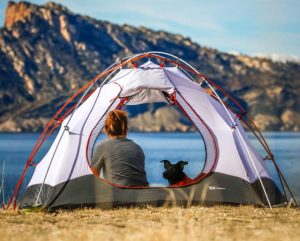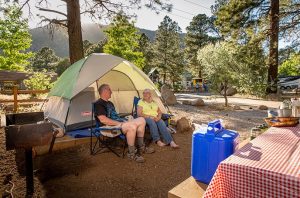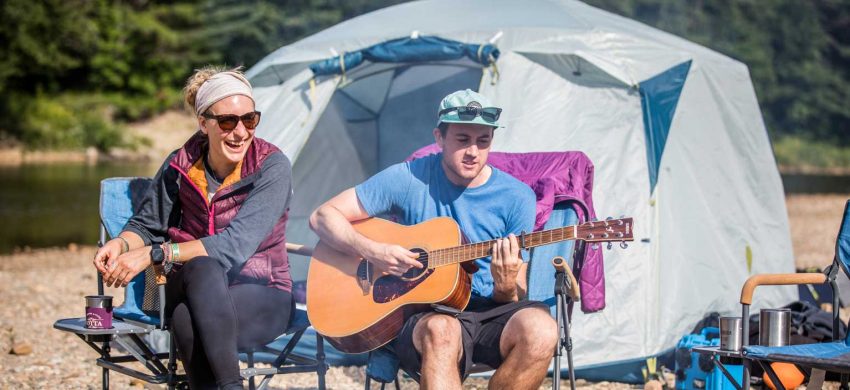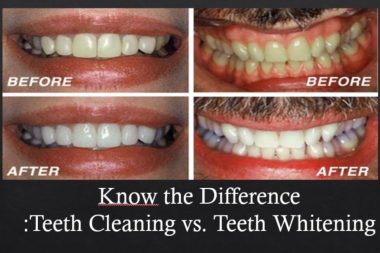Knowing how to shop for a tent can be daunting, especially if you’re new to camping. And in this time of social distancing, camping has become a newfound favorite hobby for many who want to enjoy time with friends and family while staying outside. It can be a welcome break from daily life and a chance to unplug and reconnect with nature.
Car camping with family or friends is a summer pastime for many of us. Whether the campground itself is the main attraction or it’s simply your base camp for nearby activities, this article will help you find the right camping tent—your home away from home.
So you want to buy tent! That’s great! So you don’t know where to start? That’s ok!
Buying a tent is like purchasing a car, a dress or a suit, golf clubs, or even a bottle of wine. Too much choice equals confusion. And confusion can mean making poor choices, or even giving up.
Not to worry – help is here.
Happy camping!

Decide on Cost
This is the big decision for everyone. How much to spend on a tent? We all have different budgets, but I will stress that quality costs.
I assume price will be a factor in your tent buying decision. It is for me! Tent prices for a good tent range from approximately $50.00 for budget friendly tents to hundreds of dollars for premium tents. I recommend beginner campers start out on the mid to lower end of that price range.
Just like gear for any hobby, higher quality often costs more. Don’t be discouraged though, most casual campers are happy with moderately priced tents.
Decide on Size

Whether you are backpacking light, going on a mass family camping holiday or anything in between, the size of your tent will have a huge impact on your overall trip.
Always, always, ignore the concept that a four-person tent, sleeps four. It does not. It might just sleep three, but for a comfortable experience two would be best in such a tent.
The specifications of, say, a four-person tent means that four people would be a tight fit, with no space for baggage, etc. So, a family of four should look at a six-person tent. This will give you room for bedding and smaller areas to store clothes, etc.
Should the weather be poor, that extra space will be a godsend with all of you in the tent.
Think about the space you will need in that tent and what you want to store in the tent with you.
Consider the height of adult campers – very tall people are going to need to sleep without being curled up in a ball. Know your measurements and that of the tent you are looking at.
With tents, size does matter.
Decide on Weather
Some tents are better suited to different environments.
A summer tent will be made of a lightweight material, have a lot of ventilation, and is likely not designed for harsh conditions. A three-season tent will more likely survive heavier rain and winds and provide protection from the cold.
True winter tents are probably not very common in Australia, as our conditions are more mild. However, if you are planning on camping in snow, then your tent needs to be a winter tent and not a three-season tent. Shop carefully to get the tent that suits the weather.
If you are a ‘fair-weather camper’ only – meaning you want to camp when it’s calm and sunny, your tent doesn’t need to be top of the range. Yet even the most perfect weather can change rapidly, so you need to think about your tent and how it would perform should a storm arise unexpectedly.
Some tents are better suited to different environments.
A summer tent will be made of a lightweight material, have a lot of ventilation, and is likely not designed for harsh conditions. A three-season tent will more likely survive heavier rain and winds and provide protection from the cold.
True winter tents are probably not very common in Australia, as our conditions are more mild. However, if you are planning on camping in snow, then your tent needs to be a winter tent and not a three-season tent. Shop carefully to get the tent that suits the weather.
If you are a ‘fair-weather camper’ only – meaning you want to camp when it’s calm and sunny, your tent doesn’t need to be top of the range. Yet even the most perfect weather can change rapidly, so you need to think about your tent and how it would perform should a storm arise unexpectedly.
Decide on Packability
Weight is the most important consideration, but you still need to make sure your tent fits in your backpack or easily straps to the outside of it.
Will you need to carry this tent great distances? Is it for car camping?
Some of the larger tents are extremely heavy to carry – even from the car to the campsite. Can you manage this on your own?
Some family tents are so large when packed up in their bags that we could not fit them on our roof rack. So consider that before you commit to purchase. Plus, you need some serious muscles to get that tent up on the roof of your car.

If you’ll be huffing a tent on your back, buy a backpacking-specific model, which will likely be made from lightweight materials. Sometimes people ask me about nonfreestanding tents with guylines rather than dedicated tent poles. They’re great if you’re thru-hiking because they’re ultralightweight, but for regular users, freestanding tents are much easier to set up and still pretty packable. If you’re car camping, weight isn’t an issue.
Decide on Material
Check the tent’s material closely, as this could influence your purchase choice.
Tents that are made from canvas (cotton) are waterproof but become very heavy when the water is absorbed. However, they are long lasting and don’t deteriorate as much as, say, nylon.
Nylon and polyester tents are waterproof as well, but sunlight will cause deterioration over time. With these tents, you must check that the seams have been sealed to ensure they are waterproof.
Many tents say they are waterproof, but we have found that the cheaper ones are not as waterproof as you may have hoped for. Good tents will have rip-stop fabric. 
Tent poles are made from all sorts of materials. We have upgraded some of our tent poles to better quality ones to ensure they work when we need them to work.
Also, look at the zips of the tent. This is a key part of the tent yet it is frequently overlooked. Should that tent zip fail, you could have things in your tent that aren’t welcome!
Check that the zip is a quality one, moves easily, doesn’t catch on fabric, and is non-rusting.
The fly needs to be nylon waterproofed with polyurethane or polyurethane and silicone coatings. Ideally, a fly should cover all of your tent, including windows and doors, to provide maximum protection from the rain.










Leave a Reply